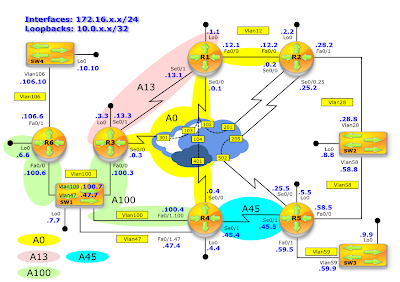Pic. 1 - Topology Diagram.
Task 1
Remove the configuration used in the previous lab.
Task 2
Remove the existing default route injection on R2 (including default static route).
Task 3
Configure R2 to generate a default route into OSPF assuming that 172.16.28.0/24 is present in its routing table.
Task 2
Remove the existing default route injection on R2 (including default static route).
Task 3
Configure R2 to generate a default route into OSPF assuming that 172.16.28.0/24 is present in its routing table.
Questions
- How can OSPF inject the default route based on the presence of specific route entry in its routing table?
Lab Solution
Solution configuration can be accessed below (if you want to save it, click the link, then go to File-->Download):
https://drive.google.com/file/d/0BwE5C95tpjZOVFZYQzlZQjQydUk/edit?usp=sharing
Task 1
Remove the configuration used in the previous lab.
R4 Config:
!
no access-list 1
!
router ospf 1
no distribute-list 1 in
no area 0 range 10.0.0.0 255.255.252.0
discard-route internal
!
R4 Config:
!
no access-list 1
!
router ospf 1
no distribute-list 1 in
no area 0 range 10.0.0.0 255.255.252.0
discard-route internal
!
Remove the existing default route injection on R2 (including default static route).
R2 Config:
!
no ip route 0.0.0.0 0.0.0.0 172.16.28.8
!
router ospf 1
no default-information originate
!
Pic. 2 - R1's Routing Table.
Configure R2 to generate a default route into OSPF assuming that 172.16.28.0/24 is present in its routing table.
R2 Config:
!
ip prefix-list VLAN28 permit 172.16.28.0/24
!
route-map CHECK permit 10
match ip address prefix-list VLAN28
!
router ospf 1
default-information originate always route-map CHECK
!
Pic. 3 - R1's Routing Table.
Now, in order to simulate the removal, shutdown FastEthernet0/1 on R2. It should no longer propagate the default route.
Pic. 4 - R2 Loses access to 172.16.28.0/24.
As a result of that, R1 no longer receives the default route from R2. This can be seen in the 'debug ip routing' on R1 activated before R2 shut down it Fas0/1 interface.
Pic. 5 - Debug IP Routing on R1 Before R2's Fas0/1 Shutdown.
Study Drill
OSPF command 'default-information originate' is already a conditional route injection. It will originate the default route into OSPF if the router has the default route itself. In case, the router with 'default-information originate' command loses the default route from its routing table, it will withdrawn the default route from OSPF domain.
OSPF can also originate the default route, without having it in its routing table. You need to add the 'default-information originate always' keyword (the one in red), to originate the default route unconditionally.
However, OSPF also uses conditional default route injection method in which the router will check for presence of any prefix specified in the route-map, just like presented in this lab.




0 comments:
Post a Comment